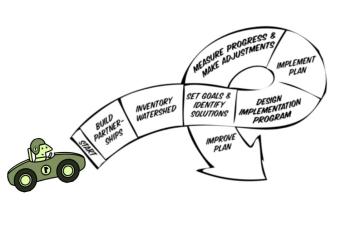For most watersheds, the key to clean water is to manage the land in a way that minimizes nonpoint source pollution. Watershed based plans developed using Section 319 subgrant funding must follow specific planning requirements and guidance and be accepted by the U.S. Environmental Protection Agency (EPA) and the department. Accepted plans are then eligible for additional Section 319 funding for plan implementation, which is awarded on a competitive basis.
Watershed based plans may be developed without Section 319 subgrant funding, but adhering to planning requirements and guidance are critical to plan acceptance and subsequent 319 funding eligibility for plan implementation.
Planning Process
A voluntary, locally-led planning process that addresses a watershed’s specific social, economic and environmental concerns helps ensure long-term success of the plan. Developing a long-term comprehensive plan should involve the local community, as well as people experienced in water resource management. Local community members, or stakeholders, have the most “at stake” in ensuring the water quality on their land is protected. They provide valuable information, leadership and management of resources in the planning process.
The planning process must include stakeholder involvement and propose management actions supported by sound science and appropriate technology. This process uses a series of cooperative, iterative steps to describe current conditions, identify and prioritize problems, define management objectives and develop and implement restoration or protection strategies as necessary.
Key Elements
A watershed based plan is like a road map, directing you from the start to finish, using action steps and strategies to reach specific goals in water quality protection and improvement. In order to ensure the success of the plan in achieving water quality goals, there are nine key elements that must be included in a watershed based plan developed with Section 319 funding:
- Causes and Sources of Pollution: Identify the watershed’s water quality problems and threats.
- Load Reductions: Estimate current pollutant loads in the watershed and determine the nonpoint source pollutant load reductions needed to meet water quality goals.
- Nonpoint Source Management Measures: Determine which nonpoint source pollution management practices need to be implemented, and where they need to be located, to optimally achieve the target load reductions.
- Technical and Financial Assistance: Describe how you will pay for implementing the plan and what technical assistance will be needed. Who are your partners? How have they committed to help?
- Information and Outreach: Develop an information/ outreach program to gain local support for the plan and its successful implementation.
- Schedule: Develop a schedule for implementing the management measures and outreach program identified in earlier steps.
- Milestones: Set interim measurable milestones that will demonstrate step-wise plan implementation according to schedule that will lead to attaining the plan’s water quality goals.
- Performance Criteria: Create criteria that can be used to establish benchmarks that will demonstrate the amount of progress being made towards achieving the plan’s water quality goals.
- Monitoring: Develop a monitoring program that will be used to collect data to assess against benchmark criteria, in order to determine when load reductions have been sufficiently achieved to meet water quality goals.
Note: EPA's 2013 Nonpoint Source Program and Grants Guidelines for States and Territories allows for alternatives to nine-element watershed based plans under specific conditions, if they adequately meet guidance requirements and are approved by EPA.


